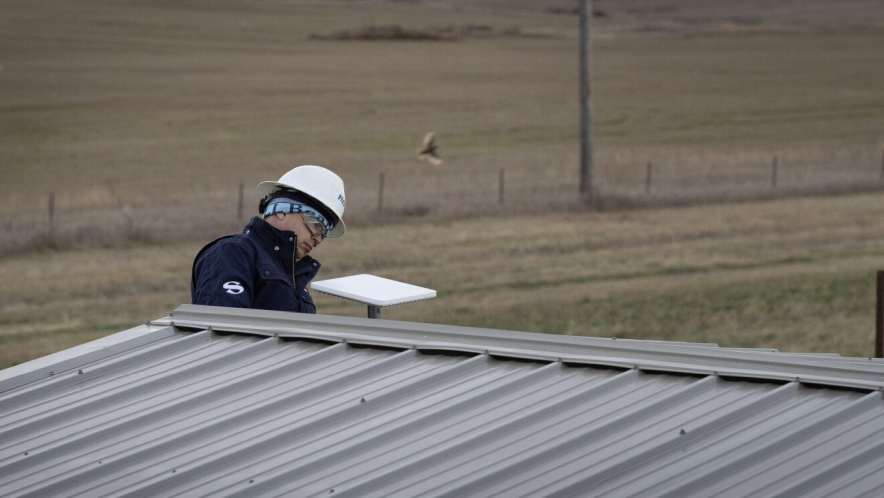Amazon unveils Leo Ultra, a 1 Gbps satellite internet terminal to challenge SpaceX Starlink

Major Highlights
-
Amazon introduces Leo Ultra, a new 1 Gbps satellite internet terminal aimed at enterprise and government users
-
Built on custom Amazon silicon with full-duplex phased array technology for simultaneous upload and download
-
Engineered for harsh, off-grid environments with a weatherproof design and integrated heat management
-
More than 150 satellites are already in orbit, with an enterprise preview program now underway before a broader rollout
-
Features include 1 Gbps download and 400 Mbps upload speeds, full-duplex phased array technology, custom Amazon Leo silicon, a weatherproof enclosure, integrated heat sink, and pole-mount installation
-
Slim 20″ x 30″ x 1.9″ design built as an enterprise-grade terminal, with broader availability expected starting in 2026
Amazon has officially pulled back the curtain on Leo Ultra, its most ambitious satellite internet terminal yet and a direct shot across the bow of SpaceX’s Starlink. Built under the rebranded Amazon Leo network, formerly known as Project Kuiper, the terminal is positioned as an enterprise-first product meant to serve governments, airlines, energy companies, logistics operators, and organizations operating far from fiber-based infrastructure. With claimed speeds of up to 1 Gbps for downloads and 400 Mbps for uploads, Leo Ultra signals that Amazon intends to be more than a quiet contender in the satellite broadband market.
Amazon CEO Andy Jassy announced the news in a post on X, saying, “Excited to share that Amazon Leo Ultra is the fastest satellite internet antenna ever built, delivering simultaneous download speeds of up to 1 Gbps and upload speeds of up to 400 Mbps, all powered by custom Leo silicon.”
This is not a consumer gadget. It’s a statement about where connectivity is headed and which companies plan to own the backbone of tomorrow’s data flow. Amazon is targeting industries where outages are not an option and where traditional networks simply don’t reach.
Amazon Leo Ultra: Built for high-demand, off-grid environments

Leo Ultra is powered by custom Amazon Leo silicon, paired with a full-duplex phased array antenna that enables simultaneous sending and receiving of data. That architecture supports consistent performance during data-heavy operations such as real-time monitoring, remote control systems, and secure communications.
The physical design reflects the mission. At 20 by 30 by 1.9 inches, the terminal is slim yet built for tough conditions. An integrated heat sink manages thermal strain. The enclosure is weatherproof. There are no moving parts. Installation is handled through simple pole mounting, allowing deployment in remote locations including oil fields, airfields, disaster zones, industrial sites, and maritime operations.
Amazon is clearly positioning this device as infrastructure, not an accessory.
A growing network in low Earth orbit
More than 150 satellites are already in orbit as part of the Amazon Leo constellation, with many more launches planned as the company moves from early testing to wider commercial availability. Initial network testing is underway, and Amazon has lined up an enterprise preview program with select partners, including JetBlue, Hunt Energy Network, Vanu, Connected Farms, and Crane Worldwide Logistics.
“Amazon Leo represents a massive opportunity for businesses operating in challenging environments,” said Chris Weber, vice president of consumer and enterprise business for Amazon Leo. “From our satellite and network design to our portfolio of high-performance phased array antennas, we’ve designed Amazon Leo to meet the needs of some of the most complex business and government customers out there, and we’re excited to provide them with the tools they need to transform their operations, no matter where they are in the world.”
Air travel is one early example. JetBlue has already signed on to test the service for in-flight connectivity. “Having collaborated with Amazon before, we knew Amazon Leo would share our passion for customer-first innovation,” said Marty St. George, president, JetBlue. “Choosing Amazon Leo reflects our commitment to staying ahead of what customers want most when traveling, such as fast, reliable performance and flexibility in our free in-flight Wi-Fi.”
Leo Ultra and Deep ties to AWS and private networks
Leo Ultra doesn’t operate in isolation. It is built to plug straight into Amazon Web Services and private enterprise networks. With Direct to AWS, customers can link remote assets to cloud workloads through AWS Transit Gateway or AWS Direct Connect Gateway. For businesses that want to bypass the public internet entirely, Private Network Interconnects provide a way to connect satellite-linked systems straight to corporate data centers at major colocation facilities.
This matters for sectors like energy, defense, logistics, and transportation, where secure and low-latency data paths are critical. Data can move from a remote site to a private cloud environment without touching the open internet, reducing exposure and tightening control.
“Hunt Energy Company operates a wide range of energy assets across the globe, and this requires exceptional connectivity to be able to operate, maintain, and deliver our products. The combination of Amazon Leo bandwidth capabilities and the secure private link is exactly what we needed,” said Hunter Hunt, CEO of Hunt Energy Holdings and Board Chairman of Skyward.
Leo Ultra: A direct challenge to Starlink

SpaceX’s Starlink currently leads the satellite broadband industry in scale and brand recognition. Amazon’s approach is different. Rather than rushing to fill homes with dishes, it is starting at the top of the stack with high-value, high-demand customers who need performance guarantees, security, and integration with cloud systems.
Leo Ultra is Amazon’s first serious move in that direction. The company has not announced pricing yet, but with its hardware specs and enterprise focus, it is expected to sit firmly in the premium category.
As more satellites launch and coverage deepens, this system aims to become part of the invisible infrastructure supporting AI workloads, autonomous systems, global transportation, remote industrial control, and emergency response operations.
What comes next
Amazon is shipping Leo Pro and Leo Ultra units to select companies through its preview program. Coverage and capacity will expand as more satellites enter orbit. The next launch with United Launch Alliance is scheduled for December 15, kicking off a series of missions that will form the initial operational network.
The satellite internet race is now firmly a two-horse competition between SpaceX and Amazon. One has scale. The other has cloud dominance, enterprise reach, and a long history of turning infrastructure into an ecosystem.
Why It Matters: Leo Ultra gives Amazon a real foothold in next-generation satellite connectivity and signals that space-based internet will be central to global communications, remote operations, and AI-driven infrastructure in the years ahead.
Watch the YouTube video below to learn more about Amazon Leo Ultra.




